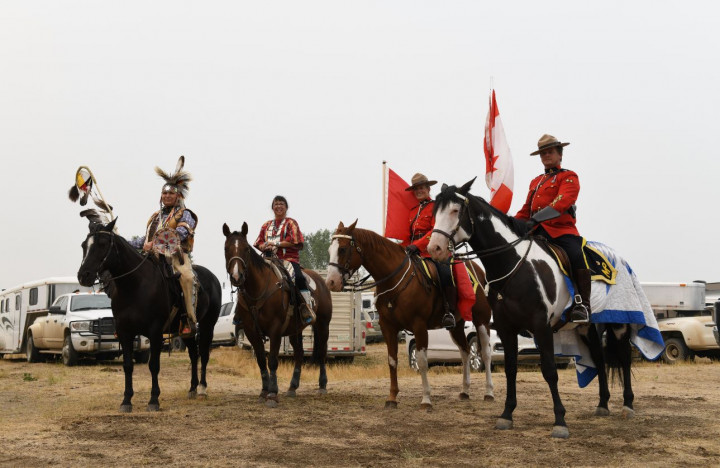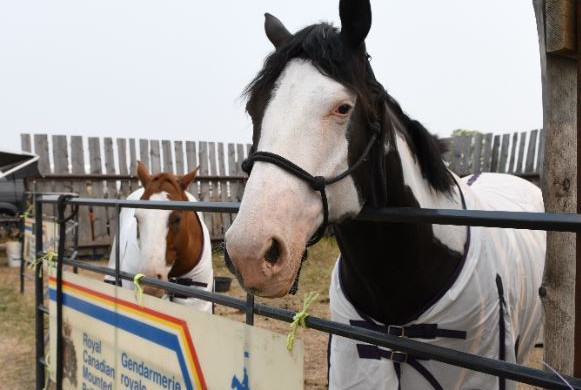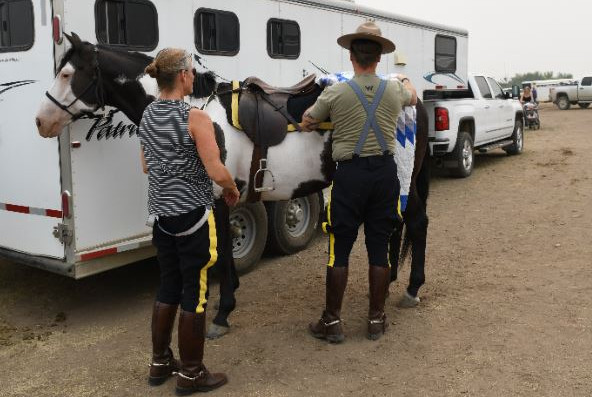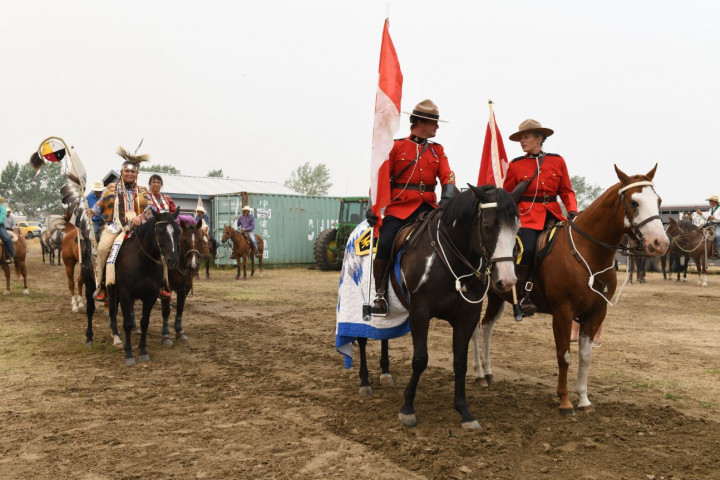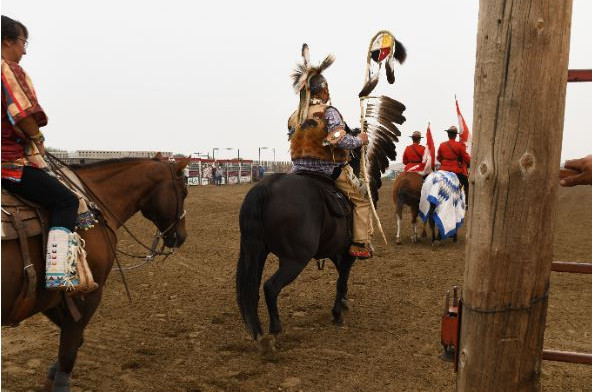As you walk onto the Wood Mountain Stampede grounds, located in Wood Mountain Regional Park in southern Saskatchewan, you feel like you could be walking into almost any prairie Stampede – there are trailers as far as the eye can see, denim-clad rodeo-goers of all ages, and horses at every turn. There is also a bushel of history here – stemming back to the early days of the RCMP, then called the "North-West Mounted Police," and the nearly 5,000 Lakota People who sought refuge here after the Battle of Little Bighorn. To Sergeant Dennis Silliker, Assiniboia RCMP Detachment Commander, walking onto those Stampede grounds made him feel as though he was walking into an opportunity to build on that history and the RCMP's present-day relationship with the local Lakota First Nation.
An invitation and an honour
The Assiniboia Detachment was asked by the Wood Mountain Lakota First Nation to ride with them during the opening ceremonies of the Stampede on August 14 and 15. Sgt. Silliker was told anecdotally that this year was the first time the RCMP would be participating in the Stampede since the 1970s.
This year's invitation was a first for the RCMP – the Lakota First Nation asked that the RCMP ride alongside them on paint horses instead of on the traditional RCMP black and browns. What is the significance of this? The Wood Mountain Lakota First Nation said it was meant to be a display of honour for Chief Sitting Bull and some of his Lakota warriors: White Bull, Fast Bear, Buffalo Standing Up, Elk Standing Up, Hawk, Dice, White Eagle, Counted Coupe Upon and Ice – a friendly Cheyenne, who were called to the Spirit World during the Battle of the Little Big Horn. The honour also extended to all those Lakota People who've been called to the Spirit World.
Cst. Tina Platford, with the Internet Child Exploitation Unit, has two paints of her own – Skip and Stuart – a breed that combines both the conformational characteristics of a western stock horse with a pinto spotting pattern of white and dark coat colors. Cst. Platford joined Sgt. Silliker in representing the RCMP during the ceremonies – riding into the arena on horseback, carrying the Canadian flag. She said of her participation, "To me, as an officer, it was an honour and a privilege to participate in the event alongside the Lakota People, particularly given the historical ties between them and the NWMP and RCMP."
The experience is something Sgt. Silliker will remember for the rest of his life: "It's a unique experience for me, professionally, to be able to participate as the Commander of Assiniboia RCMP and ride a paint horse while in Red Serge and be asked by the Lakota First Nation to carry a star blanket to honour their people. It was an honour I'll carry with me forever."
A whole lot of history
The Wood Mountain area is rich with history. The Wood Mountain Post was established as a North-West Mounted Police (NWMP) post in 1874 to patrol the Canada/United States border and police whiskey traders, horse thieves and cattle rustlers. The post rose to prominence in 1876, when Chief Sitting Bull and approximately 5,000 members of the Sioux (Lakota) First Nation took refuge in Canada after the Battle of Little Bighorn.
Shortly after the March West, the NWMP at the Wood Mountain Post used to race their horses against the Lakota First Nation horseback riders of the area - in the spirit of sportsmanship and healthy competition. These competitions were the makings of the Wood Mountain Stampede. The event was first formally held in 1890 and is the longest continuous rodeo in Canada. Rodeo-goers today will notice that vehicles parked on the event grounds have licence plates from all over Canada and into the United States – such as from the Dakotas and Montana.
Sgt. Silliker has his own ties to the history of the area and found attending the Stampede somewhat of a full-circle moment: "For me it was history coming around again. My great-grandfather was a member of the NWMP, engaged May 11, 1874, and discharged May 11, 1877, at Fort Macleod, Alberta - Regimental #83. I like to think that my great-grandfather was a Red Coat that was trusted by the Indigenous Peoples when he came through this area on the March West. Maybe in today's times I can also, in some way, honour Indigenous Peoples and their traditions and contribute to building trust once more."
Relationship-building and Reconciliation
This partnering at the Stampede is one of the steps the Saskatchewan RCMP is taking to build on its relationship with Indigenous People in the province. Sgt. Silliker says, "Reconciliation between the RCMP and the Indigenous People of Saskatchewan is a top priority for the Saskatchewan RCMP. It represents a permanent commitment to fostering respectful, trusting relationships with Indigenous people, communities, and employees through good faith, honour, and fairness. As the Commander of Assiniboia RCMP, I consider it a unique privilege to be invited to this event and to ride in Red Serge as a meaningful way for my detachment to honor our local Lakota First Nation… I think every community's journey towards Reconciliation will be different as every community and its people are different, but as long as we maintain our commitment to and respect for all parties, we are on the right path. This was our small Assiniboia RCMP way of taking a step forward, a step we could only accomplish with the help and support of our partners in the Lakota First Nation."
A day at the rodeo told in photos
The weather on August 14 and 15 was hot and hazy – due in part to the forest fires burning to the west – with very little breeze. The Stampede grounds were bustling with lots of people, horses and energy. Everyone was happy to be out despite the conditions.
Not your traditional RCMP horse: Skip (brown and white) and Stuart (black and white), two paint horses, await their chance at riding in the rodeo arena
Getting ready to ride: Sgt. Dennis Silliker and Cst. Tina Platford ready their horses for the opening ceremonies – brushing them out, saddling them up and securing the star blanket, meant to honour the Lakota People – those both living and gone - on the croup of one horse
The smiles say it all: Councillor Stanley Lethbridge, Kim Soo Goodtrack, Cst. Platford and Sgt. Silliker sit atop their horses as they wait for the day's opening ceremonies to begin
About to begin: Councillor Stanley Lethbridge, Kim Soo Goodtrack, Cst. Platford and Sgt. Silliker wait outside the arena until the ceremonies begin
An honour and a privilege: The group rides into the arena, followed by the other horse-riding flag-bearers
The day went off without a hitch (unless you count the many trailer hitches in the parking lot) – and with just one naughty horse (ahem, Stuart). Following the opening ceremonies, there was your typical rodeo fanfare: bucking broncos, cattle-roping and barrel racing. Many welcomed the RCMP's presence – the officers received words of thanks from and had plenty of conversations with attendees. Sgt. Silliker and the Assiniboia detachment take every opportunity possible to connect with the communities they serve and will continue their efforts in relationship-building.
